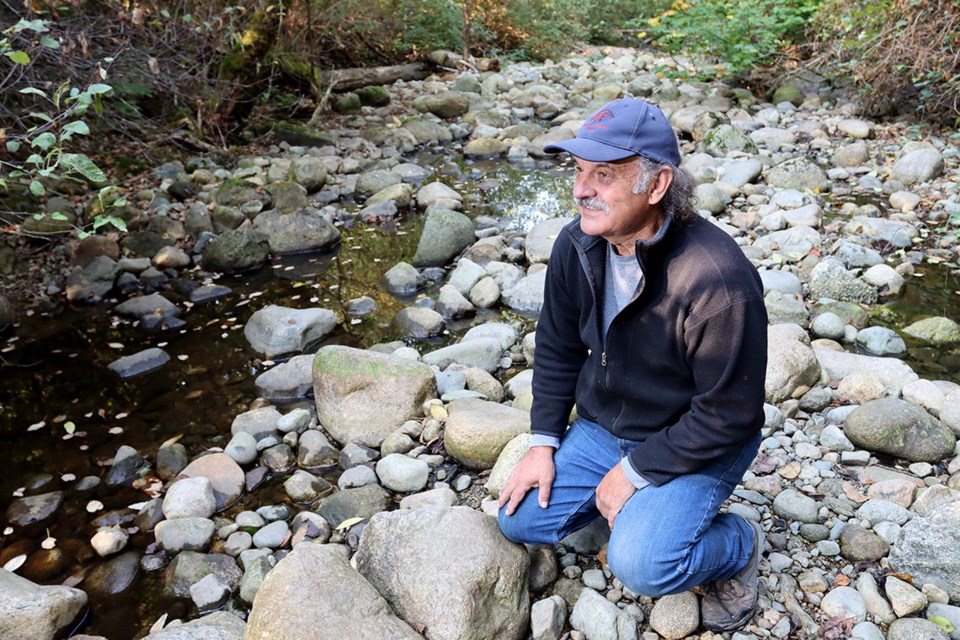The rain in Friday’s (Oct. 21) weather forecast can’t come soon enough for Port Moody’s hatcheries.
With little precipitation for more than a month, they’re struggling.
Noons Creek is more boulders than babbling brook. And while there’s plenty of water in Mossom Creek, the chum and coho salmon have yet to begin their migration up from Burrard Inlet.
Dave Bennie said he’s never seen a spawning season like this one in his 31 years at the Noons Creek hatchery.
Normally, he said, about 40 or 50 coho would already have made their way up the creek, where volunteers are able to harvest their eggs that will become the next generation of smolts raised in the hatchery’s tanks and holding pond.
But the late summer drought, which has extended a month into fall, has dried the creek to a trickle of water, and the fish have been unable to bring their lives full cycle.
Instead, they’re jumping in the waters of the Burrard Inlet.
Bennie doesn’t know how much longer they can wait.
“We’ve never been through this before,” he said, adding he doesn’t know what will happen to the fish if they’re unable to make it up the creek to spawn.
Further west along Ioco Road, Ruth Foster said Mossom Creek is fortunate to have a groundwater source that keeps it flowing briskly.
But it’s still not enough as the pools where the fish like to hide during their journey upstream aren’t deep enough.
“We have not seen a single fish,” Foster said, adding the coho should already be well into their spawning season.
It’s worrisome, she said, as the whole ecosystem around the creek is feeling the impact of the missing fish: Bears and bobcats that like to feast on the dying and dead fish don’t have an easy meal to help them fatten up for the winter months ahead, and birds that dine on the salmon’s roe have been absent altogether.
Trees and other vegetation that rely on nutrients released into the creek when the fish die are also struggling.
Moreover, the impact of a poor run this year will be felt for years to come.
“It’s a helpless feeling,” Foster said. “There’s no fix for this.”
Dr. Katrina Connors, the director of salmon watersheds programs for the Pacific Salmon Foundation, agreed the situation is dire.
“It is very unusual and very concerning to have conditions this severe, affecting every salmon region of the province,” she said, adding tens of thousands of stranded pink and chum salmon were recently found dead in Neekas Creek in the Heiltsuk First Nation territory.
Elsewhere in the province, spawning runs that have been delayed could affect egg development, the timing for juvenile emergence and the food that’s available to them.
Connors said all those factors could impact the survival of the next generation of salmon.
“This could be a major setback for salmon populations as it could lead to very low returns of salmon in future years that would come from this year’s return.”
Back at Noons Creek hatchery, Bennie whiles away his time keeping the 11,000 smolts currently growing in the holding pen well fed ahead of their eventual release next June and waiting for the fall rains to come.
With no fish to watch, visitors are scarce, school groups aren’t booking.
Even the boggy area next to the path where kids can collect bugs is just dried-up mud.
“We need one of those Pineapple Expresses,” Bennie said, referring to the weather systems that usually bring heavy rain from the warm waters of the Pacific Ocean near Hawaii.
But, he added, with the ground so dry, much of the water from one of those storms would quickly be absorbed and pollutants that have been building up on nearby roadways will wash into the creek, further endangering the salmon run.
“It’s beautiful,” Bennie said, looking up into the sunshine dappling through the trees. “But nature isn’t right right now.”



